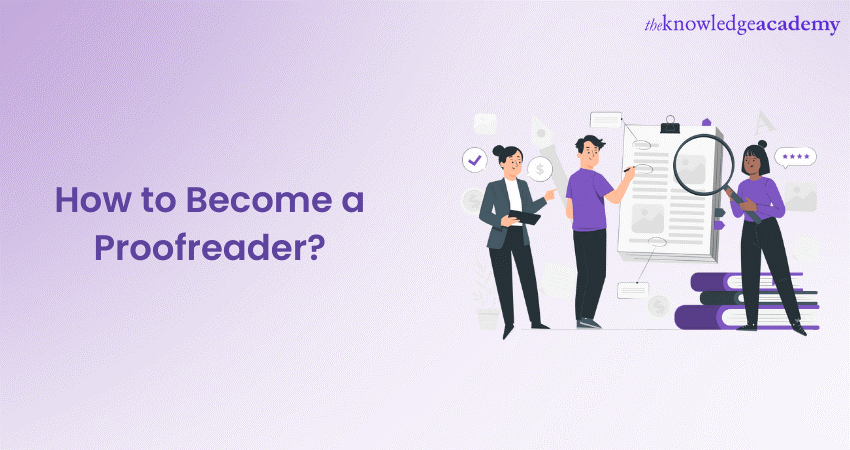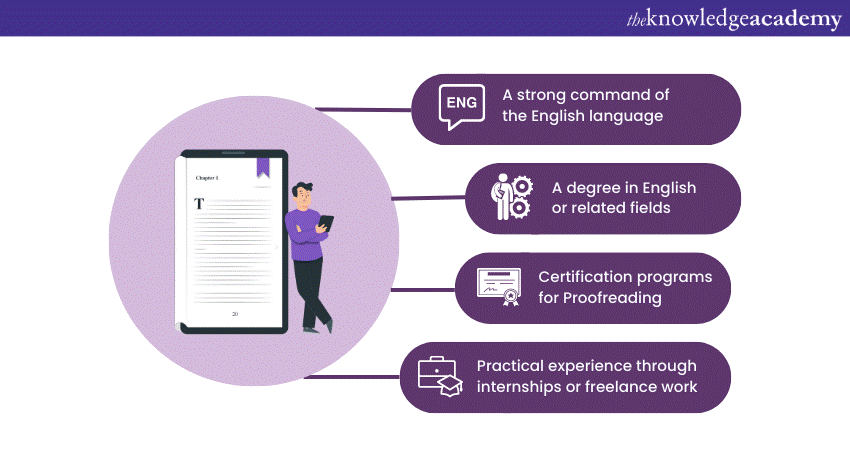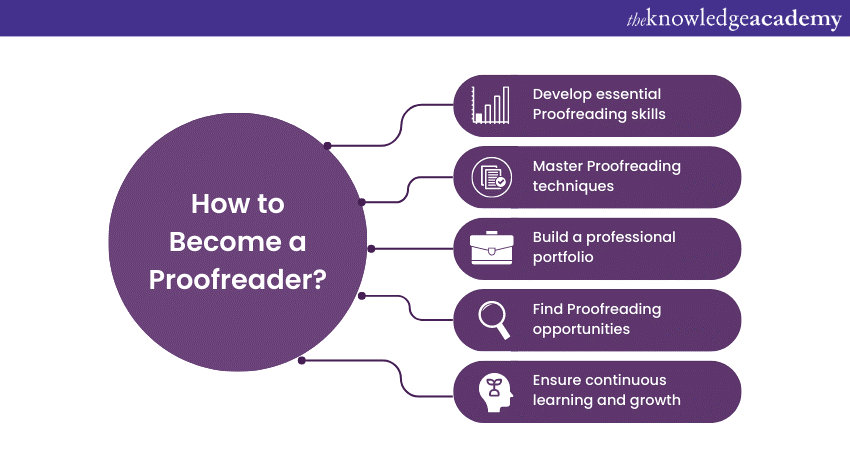We may not have the course you’re looking for. If you enquire or give us a call on 800969236 and speak to our training experts, we may still be able to help with your training requirements.
Training Outcomes Within Your Budget!
We ensure quality, budget-alignment, and timely delivery by our expert instructors.

Proofreading is a crucial aspect of the writing process. It involves carefully reviewing written content to detect and correct any errors in spelling, grammar, and punctuation. If you have a keen eye for detail, excellent language skills, and a passion for improving written communication, then becoming a Proofreader might be the perfect career choice for you. In case you are asking, “How can I become a Proofreader?”, you have all the answers here. In this blog, we will explore How to Become a Proofreader, including the steps involved in the journey of becoming a professional Proofreader.
Table of Contents
1) Understanding the role of a Proofreader
2) Educational and professional qualifications needed for a Proofreader
3) How to Become a Proofreader?
a) Develop essential Proofreading Skills
b) Master Proofreading techniques
c) Build a professional portfolio
d) Find Proofreading opportunities
e) Ensure continuous learning and growth
4) Conclusion
Understanding the role of a Proofreader
Understanding the role of a Proofreader is crucial for anyone aspiring to excel in this profession. A Proofreader's primary responsibility is to meticulously review written content to identify and correct errors in grammar, spelling, punctuation, and style. They ensure that the text is polished, accurate, and adheres to the highest standards of language proficiency.
With a keen eye for detail and proficient language skills, a Proofreader plays a vital role in improving the overall quality and readability of written materials. Their expertise extends beyond mere error detection, as they also contribute to enhancing the clarity, coherence, and effectiveness of the text. Now that we know what the role of a Proofreader is, let us move on to exploring the educational and professional qualifications required to be a Proofreader.
Elevate your Proofreading Skills with our Proofreading Masterclass Course and unlock the power of error-free written communication!
Educational and professional qualifications needed for a Proofreader
This blog section will expand on the educational and qualifications needed to be a Proofreader.

1) A strong command of the English language: A strong command of the English language is fundamental for a Proofreader. It includes proficiency in grammar, vocabulary, spelling, and sentence structure. Enhancing your language skills through reading, writing, and continuous learning is essential.
2) A degree in English or related fields: While a degree in English or a related field is not always mandatory, it can provide a solid foundation for a career in Proofreading. Studying English literature, linguistics, or communication equips you with a deeper understanding of language nuances and enhances your critical analysis skills.
3) Certification programs for Proofreading: Certification programs in Proofreading offer specialised training and demonstrate your commitment to professional development. Organisations like the Society for Editors and Proofreaders (SfEP) and the Editorial Freelancers Association (EFA) offer certification courses that can boost your credentials.
4) Practical experience through internships or freelance work: Practical experience is invaluable in the Proofreading industry. Consider internships, volunteer work, or freelance projects to gain hands-on experience. Building a portfolio of proofread samples will showcase your skills to potential clients or employers.
How to Become a Proofreader?
This section of the blog will expand on a step-by-step guide on How to Become a Proofreader.

Develop essential Proofreading Skills
Developing essential Proofreading Skills is crucial for anyone aspiring to become a successful Proofreader. Here are some key areas to focus on when developing your Proofreading Skills:
1) Attention to detail: A Proofreader must have an eye for detail and the ability to spot even the smallest errors. Pay close attention to grammar, punctuation, spelling, formatting, and consistency throughout the text. Train yourself to be thorough and meticulous in your review process.
2) Grammar and language proficiency: A strong command of grammar rules and language usage is essential. Familiarise yourself with different grammar concepts, such as subject-verb agreement, verb tenses, pronoun usage, and sentence structure. Enhance your language proficiency through reading a wide range of materials, including books, articles, and professional publications.
3) Punctuation accuracy: Mastering punctuation marks and their appropriate usage is crucial. Ensure that commas, periods, semicolons, colons, quotation marks, and other punctuation marks are used correctly and consistently. Pay attention to the nuances of punctuation rules to ensure clarity and coherence in the text.
4) Spelling precision: Develop a strong spelling ability to catch and correct spelling errors. Improve your spelling skills by regularly practising spelling exercises, referring to dictionaries, and using spelling correction tools. Be aware of commonly misspelled words and watch out for homophones, which are words that sound alike but have different spellings and meanings.
5) Consistency and style adherence: Maintain consistency in the writing style, formatting, and language conventions throughout the text. Familiarise yourself with popular style guides, such as The Oxford Style Manual or The Chicago Manual of Style, and adhere to their guidelines. Consistency ensures a professional and polished final product.
6) Critical analysis and problem-solving: Develop your analytical and problem-solving skills to identify errors and inconsistencies in written content. Be able to assess the clarity, coherence, and effectiveness of the text. Analyse the flow of ideas, organisation of paragraphs, and overall structure to provide suggestions for improvement.
7) Attention to context: Consider the context in which the text is written. Understand the target audience, purpose, and tone of the content. Ensure that the text aligns with the intended message and effectively communicates to the readers.
8) Continuous learning: The field of language and writing is constantly evolving. Stay updated with the latest grammar rules, language trends, and style guidelines. Engage in continuous learning through reading, attending workshops or webinars, and participating in professional development courses.
Master Proofreading techniques
Mastering Proofreading techniques is essential for becoming a highly skilled and efficient Proofreader. Here are some key Proofreading techniques to master:
1) Read slowly and carefully: When Proofreading, read the text slowly and carefully, word by word, to avoid overlooking errors. Pay close attention to each sentence, paragraph, and section. Avoid rushing through the content, as it can lead to missing important mistakes.
2) Read aloud: Reading the text aloud can help you spot errors and improve clarity. When you read aloud, you engage both your visual and auditory senses, which can enhance your ability to identify awkward sentence structures, grammatical errors, and inconsistencies in tone or style.
3) Proofread in multiple passes: Instead of trying to catch all errors in a single pass, consider Proofreading in multiple passes. Each pass can focus on specific aspects, such as grammar, punctuation, spelling, or formatting. This approach helps you maintain focus and improves the accuracy of your Proofreading.
4) Use Proofreading tools: Utilise Proofreading tools and software to assist you in the process. Tools like Grammarly, ProWritingAid, and Hemingway Editor can help identify grammar and spelling errors, suggest improvements, and enhance the overall quality of your Proofreading.
5) Check for consistency: Consistency is crucial in written content. Pay attention to the consistency of spelling, punctuation, formatting, capitalisation, and use of abbreviations or acronyms. Make sure that the writing style and tone are consistent throughout the document.
6) Double-check facts and references: If the content includes factual information, verify the accuracy of the facts, figures, dates, and references. Cross-reference any cited sources to ensure their reliability and correctness.
7) Take breaks: Proofreading for extended periods can lead to fatigue and decreased attentiveness. Take regular breaks to rest your eyes and mind. Returning to the content with a fresh perspective can help you identify errors more effectively.
8) Use a style guide: Refer to established style guides, such as The Oxford Style Manual or The Chicago Manual of Style, to ensure consistency and adherence to specific rules and guidelines. Style guides provide comprehensive instructions on grammar, punctuation, formatting, and citation styles.
9) Be mindful of context: Consider the context in which the content is written. Understand the intended audience, purpose, and tone of the text. Ensure that the Proofreading suggestions align with the context and do not alter the intended meaning.
10) Seek a second opinion: When working on important or high-stakes documents, consider seeking a second opinion from a trusted colleague or fellow Proofreader. Fresh eyes may catch errors or provide valuable insights that you may have missed.
Master the art of attention management and reclaim control of your time with our transformative Attention Management Training Course!
Build a professional portfolio
Building a professional portfolio is a crucial step for aspiring Proofreaders to showcase their skills, expertise, and experience. Here are some key considerations to help you build an impressive professional portfolio:
1) Select your best work: Choose a diverse range of Proofreading samples that highlight your skills and expertise. Select pieces from various genres, such as academic papers, blog articles, marketing materials, or fiction. Aim for a balance between different writing styles and formats to demonstrate your versatility.
2) Highlight before and after versions: Whenever possible, include both the original version of the content and your proofread version. This allows potential clients or employers to see the improvements you have made, emphasising the value you bring as a Proofreader.
3) Showcase different stages of editing: If you have been involved in various stages of the editing process, such as substantive editing or copyediting, include samples that demonstrate your skills in these areas. This showcases your ability to go beyond basic Proofreading and provides a comprehensive view of your capabilities.
4) Demonstrate expertise in specific subject areas: If you have expertise in certain subject areas, include Proofreading samples from those domains. For example, if you have a background in science or technology, showcase proofread samples from academic papers or technical documents within those fields.
5) Provide context for each sample: Accompany each sample with a brief description that provides context. Explain the type of document, its purpose, and any specific challenges or requirements you faced during the Proofreading process. This helps potential clients or employers understand your capabilities and the scope of your work.
6) Include testimonials and references: Incorporate testimonials from satisfied clients or references from colleagues who can vouch for your skills and professionalism. These testimonials add credibility and provide reassurance to potential clients or employers.
7) Create an online presence: Establish an online presence by creating a professional website or portfolio. This serves as a central hub for your Proofreading services and allows potential clients or employers to easily access your portfolio. Make sure that your website is user-friendly and includes your contact information.
8) Update your portfolio regularly: As you complete new Proofreading projects, add them to your portfolio to keep it up to date. Regularly review and refine your portfolio, removing outdated or less-relevant samples and replacing them with recent and impactful work.
9) Participate in professional communities: Engage with professional Proofreading communities, forums, and social media groups. Share your knowledge, contribute to discussions, and build relationships with other Proofreaders and writers. Networking within these communities can lead to valuable opportunities and collaborations.
As you gain more experience and expertise, continuously strive to improve and expand your horizon. Seek challenging projects, explore new genres, and take on different types of documents to demonstrate your versatility and growth as a Proofreader.

Find Proofreading opportunities
Finding Proofreading opportunities is crucial for establishing yourself as a professional Proofreader. To increase your chances of success, consider the following strategies:
a) Explore freelance platforms and job boards like Upwork and Freelancer.
b) Approach publishing houses, agencies, and websites directly to offer your services.
c) Network with writers, editors, and industry professionals through events and online communities.
d) Connect with content creators and authors who often require Proofreading assistance.
e) Seek opportunities in academic and research institutions for scholarly papers and dissertations.
f) Register with professional directories and listings such as the EFA or CIEP directories.
g) Establish a strong social media presence to showcase your expertise and attract potential clients.
h) Use cold pitching and direct marketing by reaching out to businesses and organisations.
i) Leverage referrals and testimonials from satisfied clients to expand your client base.
j) Collaborate with other professionals in the industry, such as editors or content strategists.
Strategies for continuous learning and growth
Continuous learning and growth are essential for professional Proofreaders. To ensure ongoing development, follow these strategies below:
a) Stay updated with language and writing trends by reading industry blogs and publications.
b) Participate in workshops and training programs to enhance your Proofreading Skills.
c) Expand your knowledge in specific domains and industries to provide specialised services.
d) Engage with professional communities to exchange ideas and stay updated on industry trends.
e) Seek feedback from clients and colleagues to continuously improve your Proofreading abilities.
f) Read widely across various genres to enhance language proficiency and understanding.
g) Adapt to technological advancements by exploring relevant tools and resources.
h) Set personal development goals and regularly review your progress towards achieving them.
Conclusion
All in all, becoming a Proofreader requires a combination of skills, qualifications, and continuous learning. By following the steps outlined in this blog, aspiring Proofreaders can embark on a rewarding career path. Remember, practice and persistence are key to becoming a skilled Proofreader. Hope this blog answered all your questions about How to Become a Proofreader!
Ignite your personal development journey with our comprehensive Personal Development Training Courses and unlock your true potential today!







 Top Rated Course
Top Rated Course



 If you wish to make any changes to your course, please
If you wish to make any changes to your course, please


